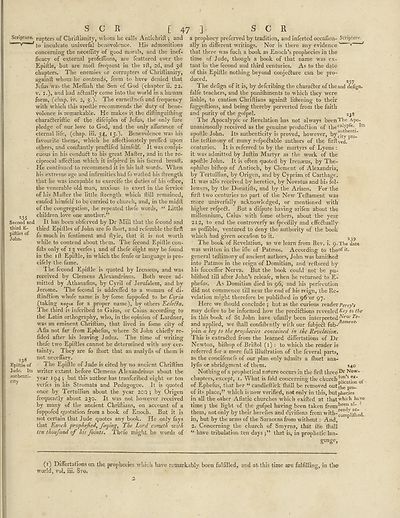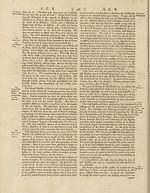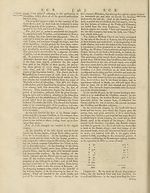Encyclopaedia Britannica, or, a Dictionary of arts, sciences, and miscellaneous literature : enlarged and improved. Illustrated with nearly six hundred engravings > Volume 19, Scripture-SUG
(53) Page 47
Download files
Complete book:
Individual page:
Thumbnail gallery: Grid view | List view

S C R
£
Scripture.
235 ,
Second and
third E-
piftles of
John.
23d
Epiitie of
Jude. Its
authenti¬
city
rupters of Chriftianity, whom he calls Antichrlft j
to inculcate univerfal benevolence. His admonitions
concerning the neceflity of good morals, and the inef¬
ficacy of external profeffions, are fcattered over the
Epiftle, but are moil frequent in the ill, 2d, and 3d
chapters. The enemies or corrupters of Chrillianity,
againll whom he contends, feem to have denied that
Jefus was the Mefliah the Son of God (chapter ii. 22.
v. 1.), and had aflually come into the world in a human
form, (chap. iv. 2, 3.). The earneftnefs and frequency
with which this apoltle recommends the duty of bene¬
volence is remarkable. He makes it the diftinguilhing
charaileriftic of the difciples of Jefus, the only fure
pledge of our love to God, and the only affurance of
eternal life, (chap. iii. 34, 15.). Benevolence was his
favourite theme, which he affectionately preffed upon
others, and conllantly praClifed himfelf. It was conlpi-
cuous in his conduCl to his great Matter, and in the re¬
ciprocal affedlion which it infpired in his facred breaft.
He continued to recommend it in his laft words. When
his extreme age and infirmities had fo walled his llrength
that he was incapable to exercife the duties of his office,
the venerable old man, anxious to exert in the fervice
of his Mailer the little llrength which Hill remained,
eaufed himfelf to be carried to church, and, in the midll
of the congregation, he repeated thefe words, “ Little
children love one another.”
It has been obferved by Dr Mill that the fecond and
third Epillles of John are fo ffiort, and referable the firft
fo much in fentiment and llyle, that it is not worth
ivhile to contend about them. The fecond Epiltle con-
fills only of 13 verfes •, and of thefe eight may be found
in the ill Epiltle, in which the fenfe or language is pre-
cifely the fame.
I he fecond Epiltle is quoted by Irenams, and was
received by Clemens Alexandrinus. Both were ad¬
mitted by Athanafius, by Cyril of Jerufalem, and by
Jerome. The fecond is addreffed to a woman of di-
IlinClion whofe name is by fome fuppofed to be Cijria
(taking y-v^u, for a proper name), by others Kc/e£ia.
The third is infcribed to Gaius, or Caius according to
the Latin orthography, who, in the opinion of Lardner,
was an eminent Chriltian, that lived in fome city of
Alia not far from Ephefus, where St John chiefly re-
lided after his leaving Judea. The time of writing
thefe two Epillles cannot be determined with any cer¬
tainty. They are fo Ihort that an analyfis of them is
not neceffary.
The Epiltle of Jude is cited by no ancient Chriltran
writer extant before Clemens Alexandrinus about the
year 194 ; but this author has tranfcribed eight or ten
verfes in his Stromata and Pedagogue. It is quoted
once by Tertullian about the year 20Q ; by Origen
frequently about 230. It was not however received
by many of the ancient Chriltians, on account of a
fuppofed quotation from a book of Enoch. But it is
not certain that Jude quotes any book. He only fays
that Enoch prophejied, faying, The Lord cometh with
ten thoufand of his faints. Thefe might be words of
47 J- S G R .
and a prophecy preferved by tradition, and inferted occafion- Scripture,
ally in different writings. Nor is there any evidence —v—
that there was fuch a book as Enoch’s prophecies in the
time of Jude, though a book of that name was ex¬
tant in the fecond and third centuries. As to the date
of this Epiltle nothing beyond conjedlure can be pro-
duced. _ . . 237
The defign of it is, by deferibing the chara&er of the and delign.
falfe teachers, and the punilhments to which they were
liable, to caution Chriltians againll lillening to their
fuggeltions, and being thereby perverted from the faith
and purity of the gofpel. 2jS
The Apocalypfe or Revelation has not always been The Apo-
unanimoully received as the genuine production of thecal^Pfe‘. Its
apoltle John. Its authenticity is proved, however, by
the tellimony of many refpeClable authors of the firllVed/
centuries. It is referred to by the martyrs of Lyons :
it was admitted by Jultin Martyr as the work of the
apoltle John. It is often quoted by Irenaeus, by The-
ophilus bilhop of Antioch, by Clement of Alexandria,
by Tertullian, by Origen, and by Cyprian of Carthage.
It was alfo received by heretics, by Novatus and his fol¬
lowers, by the Donatills, and by the Arians. For the
firlt two centuries no part of the New Teltament was
more univerfally acknowledged, or mentioned with
higher refpedt. But a difpute having arifen about the
millennium, Caius with fome others, about the year
212, to end the controverfy as fpeedily and effeCtually
as poflible, ventured to deny the authority of the book
which had given occafion to it.
The book of Revelation, as we learn from Rev. i. 9. The date
was written in the ifle of Patmos. According to th©of it*
general tellimony of ancient authors, John was baniffied
into Patmos in the reign of Domitian, and reltored by
his fucceffor Nerva. But the book could not be pu-
blifhed till after John’s releafe, when he returned to E-
phefus. As Domitian died in 96, and his perfecution
did not commence till near the end of his reign, the Re¬
velation might therefore be publilhed in 96'or 97.
Here we ffiould conclude j but as the curious reader Percy's
may defire to be informed hovr the predictions revealed Key to the
in this book of St John have ufually been interpretedTe~
and applied, wTe lhall confiltently with our fubjeft {u\)-ment'
join a key to the prophecies contained in the Revelation.
This is extracted from the learned differtations of Dr
Newton, bilhop of Briltol (1) : to which the reader is
referred for a more full illultration of the feveral parts,
as the concifenefs of our plan only admits a fhort ana¬
lyfis or abridgment of them. 140
Nothing of a prophetical nature occurs in the firlt three Dr New-
chapters, except, 1. What is laid concerning the church t?”,s
of Ephefus, that her “ candleltick ihall be removed out thep^o- °
of its place,” which is now verified, not only in this, butphecies
in all the other Afiatic churches which exifted at that which have
time $ the light of the gofpel having been taken from^ee“ a‘"
them, not only by their herefies and divifions from with-^.4^’^
in, but by the arms of the Saracens from without : And,
2. Concerning the church of Smyrna, that IHe {hall
“ have tribulation ten days j” that is, in prophetic lan-
guage,
(1) Differtations on the prophecies which have remarkably, been fulfilled, and at this time are fulfilling, in the*
world, vol. iii. 8vo.
2
£
Scripture.
235 ,
Second and
third E-
piftles of
John.
23d
Epiitie of
Jude. Its
authenti¬
city
rupters of Chriftianity, whom he calls Antichrlft j
to inculcate univerfal benevolence. His admonitions
concerning the neceflity of good morals, and the inef¬
ficacy of external profeffions, are fcattered over the
Epiftle, but are moil frequent in the ill, 2d, and 3d
chapters. The enemies or corrupters of Chrillianity,
againll whom he contends, feem to have denied that
Jefus was the Mefliah the Son of God (chapter ii. 22.
v. 1.), and had aflually come into the world in a human
form, (chap. iv. 2, 3.). The earneftnefs and frequency
with which this apoltle recommends the duty of bene¬
volence is remarkable. He makes it the diftinguilhing
charaileriftic of the difciples of Jefus, the only fure
pledge of our love to God, and the only affurance of
eternal life, (chap. iii. 34, 15.). Benevolence was his
favourite theme, which he affectionately preffed upon
others, and conllantly praClifed himfelf. It was conlpi-
cuous in his conduCl to his great Matter, and in the re¬
ciprocal affedlion which it infpired in his facred breaft.
He continued to recommend it in his laft words. When
his extreme age and infirmities had fo walled his llrength
that he was incapable to exercife the duties of his office,
the venerable old man, anxious to exert in the fervice
of his Mailer the little llrength which Hill remained,
eaufed himfelf to be carried to church, and, in the midll
of the congregation, he repeated thefe words, “ Little
children love one another.”
It has been obferved by Dr Mill that the fecond and
third Epillles of John are fo ffiort, and referable the firft
fo much in fentiment and llyle, that it is not worth
ivhile to contend about them. The fecond Epiltle con-
fills only of 13 verfes •, and of thefe eight may be found
in the ill Epiltle, in which the fenfe or language is pre-
cifely the fame.
I he fecond Epiltle is quoted by Irenams, and was
received by Clemens Alexandrinus. Both were ad¬
mitted by Athanafius, by Cyril of Jerufalem, and by
Jerome. The fecond is addreffed to a woman of di-
IlinClion whofe name is by fome fuppofed to be Cijria
(taking y-v^u, for a proper name), by others Kc/e£ia.
The third is infcribed to Gaius, or Caius according to
the Latin orthography, who, in the opinion of Lardner,
was an eminent Chriltian, that lived in fome city of
Alia not far from Ephefus, where St John chiefly re-
lided after his leaving Judea. The time of writing
thefe two Epillles cannot be determined with any cer¬
tainty. They are fo Ihort that an analyfis of them is
not neceffary.
The Epiltle of Jude is cited by no ancient Chriltran
writer extant before Clemens Alexandrinus about the
year 194 ; but this author has tranfcribed eight or ten
verfes in his Stromata and Pedagogue. It is quoted
once by Tertullian about the year 20Q ; by Origen
frequently about 230. It was not however received
by many of the ancient Chriltians, on account of a
fuppofed quotation from a book of Enoch. But it is
not certain that Jude quotes any book. He only fays
that Enoch prophejied, faying, The Lord cometh with
ten thoufand of his faints. Thefe might be words of
47 J- S G R .
and a prophecy preferved by tradition, and inferted occafion- Scripture,
ally in different writings. Nor is there any evidence —v—
that there was fuch a book as Enoch’s prophecies in the
time of Jude, though a book of that name was ex¬
tant in the fecond and third centuries. As to the date
of this Epiltle nothing beyond conjedlure can be pro-
duced. _ . . 237
The defign of it is, by deferibing the chara&er of the and delign.
falfe teachers, and the punilhments to which they were
liable, to caution Chriltians againll lillening to their
fuggeltions, and being thereby perverted from the faith
and purity of the gofpel. 2jS
The Apocalypfe or Revelation has not always been The Apo-
unanimoully received as the genuine production of thecal^Pfe‘. Its
apoltle John. Its authenticity is proved, however, by
the tellimony of many refpeClable authors of the firllVed/
centuries. It is referred to by the martyrs of Lyons :
it was admitted by Jultin Martyr as the work of the
apoltle John. It is often quoted by Irenaeus, by The-
ophilus bilhop of Antioch, by Clement of Alexandria,
by Tertullian, by Origen, and by Cyprian of Carthage.
It was alfo received by heretics, by Novatus and his fol¬
lowers, by the Donatills, and by the Arians. For the
firlt two centuries no part of the New Teltament was
more univerfally acknowledged, or mentioned with
higher refpedt. But a difpute having arifen about the
millennium, Caius with fome others, about the year
212, to end the controverfy as fpeedily and effeCtually
as poflible, ventured to deny the authority of the book
which had given occafion to it.
The book of Revelation, as we learn from Rev. i. 9. The date
was written in the ifle of Patmos. According to th©of it*
general tellimony of ancient authors, John was baniffied
into Patmos in the reign of Domitian, and reltored by
his fucceffor Nerva. But the book could not be pu-
blifhed till after John’s releafe, when he returned to E-
phefus. As Domitian died in 96, and his perfecution
did not commence till near the end of his reign, the Re¬
velation might therefore be publilhed in 96'or 97.
Here we ffiould conclude j but as the curious reader Percy's
may defire to be informed hovr the predictions revealed Key to the
in this book of St John have ufually been interpretedTe~
and applied, wTe lhall confiltently with our fubjeft {u\)-ment'
join a key to the prophecies contained in the Revelation.
This is extracted from the learned differtations of Dr
Newton, bilhop of Briltol (1) : to which the reader is
referred for a more full illultration of the feveral parts,
as the concifenefs of our plan only admits a fhort ana¬
lyfis or abridgment of them. 140
Nothing of a prophetical nature occurs in the firlt three Dr New-
chapters, except, 1. What is laid concerning the church t?”,s
of Ephefus, that her “ candleltick ihall be removed out thep^o- °
of its place,” which is now verified, not only in this, butphecies
in all the other Afiatic churches which exifted at that which have
time $ the light of the gofpel having been taken from^ee“ a‘"
them, not only by their herefies and divifions from with-^.4^’^
in, but by the arms of the Saracens from without : And,
2. Concerning the church of Smyrna, that IHe {hall
“ have tribulation ten days j” that is, in prophetic lan-
guage,
(1) Differtations on the prophecies which have remarkably, been fulfilled, and at this time are fulfilling, in the*
world, vol. iii. 8vo.
2
Set display mode to:
![]() Universal Viewer |
Universal Viewer | ![]() Mirador |
Large image | Transcription
Mirador |
Large image | Transcription
Images and transcriptions on this page, including medium image downloads, may be used under the Creative Commons Attribution 4.0 International Licence unless otherwise stated. ![]()
| Permanent URL | https://digital.nls.uk/192695971 |
|---|
| Attribution and copyright: |
|
|---|
| Description | Ten editions of 'Encyclopaedia Britannica', issued from 1768-1903, in 231 volumes. Originally issued in 100 weekly parts (3 volumes) between 1768 and 1771 by publishers: Colin Macfarquhar and Andrew Bell (Edinburgh); editor: William Smellie: engraver: Andrew Bell. Expanded editions in the 19th century featured more volumes and contributions from leading experts in their fields. Managed and published in Edinburgh up to the 9th edition (25 volumes, from 1875-1889); the 10th edition (1902-1903) re-issued the 9th edition, with 11 supplementary volumes. |
|---|---|
| Additional NLS resources: |
|

